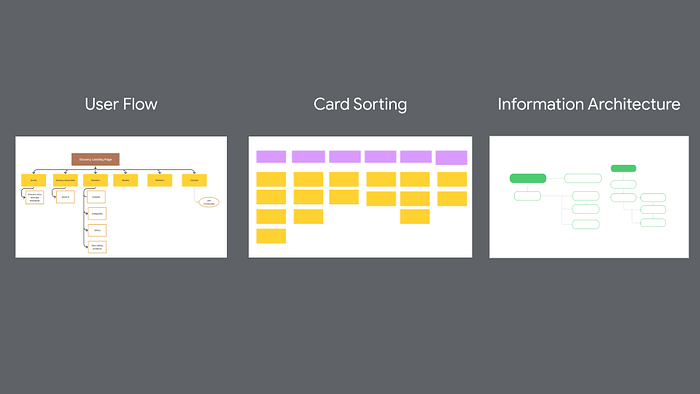The success of a website or app relies heavily on its user interface (UI) and user experience (UX). A good UI/UX design may determine whether a person stays or leaves your site. In this blog, we’ll look at what design thinking is, and how it helps make better UI/UX designs.
What is Design Thinking?
Design thinking is a creative technique for figuring out how users feel, think, and interact with your product or service. You may decipher their demands to improve user interfaces (UI) and user experiences (UX). It’s simpler to design practical goods, services, and experiences that resonate with consumers in the correct manner when you focus on user requirements and behaviors instead of merely finding out how technology works.
How does Design Thinking helps make better UI/UX designs?
The process of design thinking involves five steps: Empathy, Definition, Ideation, Implementation, and Testing.

Design thinking is not a linear process, and the phases do not have to be followed in order, although empathy is a good place to start.

- Empathy: The first step in design thinking is empathy, which is all about understanding your users and their needs. This can be done through user research, surveys, interviews, and observing user behavior.
How will the research process operate in this case?
1. Quantitative research is described as a systematic analysis of phenomena through the collection of measurable data and the use of statistical, mathematical, and computational approaches. Example : Google Analystics / Bit.ly.com
2. Qualitative research — Qualitative research may be used to learn more about how a person subjectively perceives and interprets their social world. As though you were having one:! You may learn about your user’s sentiments, emotions, and ideas by conducting an interview with them.
3. Primary research is defined as research that involves the acquisition of original data that is specific to a certain product (working from scratch — 1:1 Interviews, Focus Groups , Surveys)
4. Secondary research is summarising or synthesizing data and material that has already been compiled and published by others. (For instance, the Redesign team will begin working based on data from play store reviews — usability testing)
You don’t need to have many people for your research works, try to have your target users 3–5, it will save your time and typically gives much data to move to the next step.
- Definition: The next step is to define the problem that you want to solve. This is done by synthesizing the information gathered in the empathy stage to come up with a clear problem statement. This can be done through User Persona, Empathy Map, and User Journey Map.

USER PERSONA — The intended user is not the same as the persona. A persona is a semi-fictitious figure based on a real-life consumer. We may construct it using primary research and data gathered through 1:1 interviews. We need it to develop and refine ideas in many ways to process the design. During ideations, we employ personas to better understand the user’s goals in certain scenarios.
EMPATHY MAP — It can be created by determining the target audience
We may do our study using forms or any other data-gathering technology to obtain user feedback in order to fix the problem by observing the user and conducting interviews to learn what they think, see, hear, say, and do.USER JOURNEY MAP — depicts an individual’s interactions with a product or brand across time and across several channels. A typical user journey map displays a timeline of all of the interactions between a user and a product, including all channels via which people interact with the product.
- Ideation: The third stage is ideation, which is all about generating creative solutions to the problem. This can be done through Brainstorming, Mindmapping(User Flow), card sorting, and information architecture

USER FLOW can be classified into Task Flow — (Focusing on a single task- only a page — i.e., a landiNg page) , Classic User Flow — Focusing on multiple tasks or whole app or entire solution and Wireflow— usinging wire frames
CARD SORTING — entails having participants (the people you’re interviewing) categorize issues into categories that make sense to them. This is a technique for assessing a website’s information architecture.
INFORMATION ARCHITECTURE— will be designed to organize and classify the material so that people can easily understand it and discover it.
- Implementation: This is an experimental stage whose goal is to find the best solution for each of the challenges highlighted in the previous three stages. We may also refer to it as visual communication when it comes to seeing our ideas — from sketching to prototype. (which is when you take your ideas and turn them into reality).

Wireframes/Sketching serve as the skeleton of your digital product whereas Visual design/prototypes provide your product a more visual depiction.
- Testing: The final stage is testing, which is when you gather user input on the prototypes you’ve created as well as acquire a better grasp of your audience. This feedback can be used to make further improvements to your designs.
Design thinking establishes a method for the team to not only ask questions but also to be more flexible and collaborative in their approach to each challenge, allowing us to solve problems more effectively. It’s not something you can use once and then know all there is to know about that issue, but it’s still a valuable tool to have in your toolbox.
To summarise, design thinking isn’t magic, but it may assist a team in breaking out of their comfort zone and creating something new and innovative.
Check out my latest blog on a proper roadmap to becoming a self-taught UI/UX Designer
If you have read this far, I really appreciate it. Hope this blog n helps you find your perfect mentor. Do give a follow to get to know more about such insights. Do share your valuable opinion or other blog topic suggestions, I appreciate your honest feedback!
